|
|
|
Sort Order |
|
|
|
Items / Page
|
|
|
|
|
|
|
| Srl | Item |
| 1 |
ID:
122908
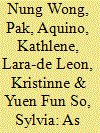

|
|
|
|
|
| Publication |
2013.
|
| Summary/Abstract |
In recent years, transnational Chinese investors from the Greater China region have been seeking natural and mineral resources in foreign countries. This paper focuses on a mineral-rich region in the Philippines where China's resource-led diplomacy was first launched in 2007. Although foreign Chinese mining companies have made inroads into mineral-rich local communities, they have also encountered resistance from non-state actors, causing their operations to be disrupted and suspended. The authors argue that the local reception of China's resource-led diplomacy can be attributed to two factors. First, in light of the debate on 'China's globalization versus South East Asian state sovereignty', the growing strength of the Philippine state in resisting transnational mining endeavours hinges on the democratic space constituted by both state and non-state actors, resulting from political decentralization and active social activism. Second, it shows that the transnational Chinese actors have an insufficient knowledge base, in which they privilege a top-down state-centric approach that reinforces the patrimonial rule of the Philippine politicians. The authors conclude, first, that such patrimonial rule is largely made possible through the provincial governor as the key agent connecting the national state authority, local government units, mining operators/investors and the affected villagers. Second, local resistance to resource-led patrimonial rule hinges on the formation of Philippine democratic space. This space remains transient and unpredictable in nature, and so cannot be assimilated into the patrimonial character of the Philippine state. Such democratic struggle is like wind, thunder and lightning - hard to chase, hard to catch.
|
|
|
|
|
|
|
|
|
|
|
|
|
|
|
|
| 2 |
ID:
122910


|
|
|
|
|
| Publication |
2013.
|
| Summary/Abstract |
Since the Asian financial crisis in 1997, there has been renewed interest in corporate governance policies and practices. This study focuses on corporate governance practices in Malaysia, where the increasing incidence of fraud suggests a lack of adequate corporate governance systems in Malaysian listed companies. Using an unbalanced data set comprising 200 companies representing a total of 579 firm-year observations, this study examines the effects of internal corporate governance mechanisms on the occurrence of fraud. Specifically, it looks at the effects of board characteristics, ownership structure and quality of audit on the occurrence of fraud in Malaysian listed companies from 2007 to 2009. The findings indicate that the number of board meetings was positively associated with the occurrence of fraud, but both state and foreign ownership revealed a negative correlation, whereas factors including the number of independent directors, board size, CEO duality and the quality of audit had no observable effects.
|
|
|
|
|
|
|
|
|
|
|
|
|
|
|
|
| 3 |
ID:
122906
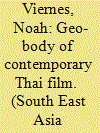

|
|
|
|
|
| Publication |
2013.
|
| Summary/Abstract |
Contemporary Thai films such as Salween (Chatrichalerm Yukol, 1995), Handle Me With Care (Kongdej Jaturanrasamee, 2008) and Mysterious Object at Noon (Apichatpong Weerasethakul, 2000) emphasize connections between geographical space and national belonging in unconventional ways. By employing new creative techniques to present continuing political conflicts in the region, these films lay claim to a visual tradition of territorial recognition. This article interprets this recent cinematic direction as a continuation of Thongchai Winichakul's critique of the 'geo-body'. The geo-body, a conceptual framing that links seeing subjects with visual representations, enables the imagination of national space by mapping bodies. This article shows how the aesthetic techniques of film reorient the imagination of national space through a reconfiguration of the geo-body of film.
|
|
|
|
|
|
|
|
|
|
|
|
|
|
|
|
| 4 |
ID:
122904
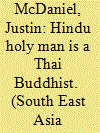

|
|
|
|
|
| Publication |
2013.
|
| Summary/Abstract |
Looking closely at the figures of the Brahmin and the hermit in Thai Buddhism, the author argues that, despite the prevalence of these figures in modern and pre-modern Thai art, literature and ritual, it should not be assumed that the presence of statues of Brahmins, hermits, or deities such as Indra, Siva, Laksmi, Ganesa and Brahma represents the presence of 'Hindu' influence or Hinduism in Thailand. The author argues that when we separate Hindu figures from the study of Thai Buddhist practice we do not see them as part of Thai Buddhism.
|
|
|
|
|
|
|
|
|
|
|
|
|
|
|
|
| 5 |
ID:
122907
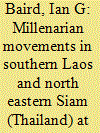

|
|
|
|
|
| Publication |
2013.
|
| Summary/Abstract |
Interrelated holy men millenarian movements destabilized southern Laos and North East Siam (Isan) at the turn of the twentieth century. In contrast to those who have interpreted these uprisings as purely anti-state, the author presents evidence to suggest that Champassak royals played crucial roles in supporting the revolts, even to the extent of masterminding rebellions against both the French and the Siamese in order to enhance their own power. The findings of this research illustrate the varying power structures that existed within lowland states in mainland South East Asia at the beginning of the twentieth century, a point that has implications with regard to James Scott's (2009) arguments in The Art of Not Being Governed: An Anarchist History of Upland Southeast Asia.
|
|
|
|
|
|
|
|
|
|
|
|
|
|
|
|
| 6 |
ID:
122905
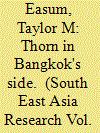

|
|
|
|
|
| Publication |
2013.
|
| Summary/Abstract |
Scholarship on the integration of Siam's northern periphery has largely overlooked the role of sacred space in the transition to modernity. While Lanna had been politically and economically integrated into modern Siam, sacred space remained a contested point of articulation between local elites and Bangkok officials long into the twentieth century. Khruba Sriwichai's movement to restore sacred spaces throughout the region shows not only how resistance to Siam continued well after the political-economic integration of the region, but also how this resistance drew on the legacy of sacro-spatial legitimacy, once a crucial part of the pre-modern Chiang Mai state.
|
|
|
|
|
|
|
|
|
|
|
|
|
|
|
|
| 7 |
ID:
122909
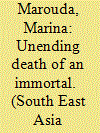

|
|
|
|
|
| Publication |
2013.
|
| Summary/Abstract |
Focusing on contemporary Viêt Nam, this article examines the monumentalizing project concerning the life, revolutionary career and political legacy of Hô Chí Minh. After Hô's death and especially after the introduction of doi moi, or renovation policies, the revolutionary state instigated a process of making memorials out of the places where he lived and struggled for the nation, projecting his biography onto the country's landscape. The article explores a series of ambiguities and uncertainties that, in a Derridian manner, haunt the state commemoration of Hô Chí Minh, and that are primarily manifested in his incomplete kinship status and imperfect death.
|
|
|
|
|
|
|
|
|
|
|
|
|
|
|
|
|
|
|
|
|